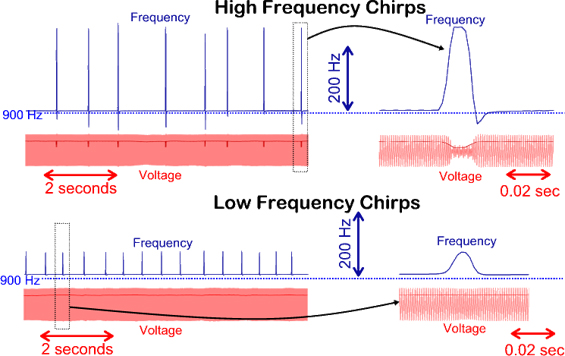Learn About Electric Fish
Modulations of the EOD and electrocommunication
The Jamming Avoidance Response (JAR) and Long-term Frequency Elevations (LTFE)
Electric fish detect nearby objects by analyzing how the objects perturb the amplitude and timing of their EODs. When two electric fish are near each other, their EODs may interfere with each other and disrupt their ability to electrolocate. This disruption is greatest when the EOD frequencies of the fish are close to each other (i.e., 4-20 Hz apart). Many species of electric fish express a reflexive behavior called the jamming avoidance response (JAR, Heiligenberg, 1973). The fish that has the higher EOD frequency will raise its EOD frequency away from that of the other fish. In some species, the fish with the lower EOD frequency will decrease the frequency of its EOD (Heiligenberg 1977; Heiligenberg et al. 1996).
If the jamming EOD is transient, the EOD frequency will return to its baseline after the jamming EOD is removed. If a fish is exposed to a jamming EOD for a long period of time, however, the frequency of the EOD may remain elevated even after the jamming EOD is removed (Oestreich and Zakon 2002). This behavior is known as a long-term frequency elevation (LTFE).
Chirps and Rises
When electric fish interact they can rapidly modulate both the frequency and amplitude of their EODs to produce communication signals that have been called pings, chirps, rises, interruptions, and yodels. Although chirps vary in structure both within and between species, the most common type of chirp involves a transient (less than a second) increase in EOD frequency.
Chirping has been most extensively studied in the brown ghost knifefish (Apteronotus leptorhynchus). Chirping is highly sexually dimorphic in this species. Male brown ghosts chirp 10-20 times more often than females. These fish also produce distinct types of chirps: Low-frequency chirps, in which EOD frequency rises ~30-130 Hz above its baseline; and High-frequency chirps, in which EOD frequency rises 170-400 Hz above its baseline. Both sexes produce low-frequency chirps, but high-frequency chirps are produced primarily by males. Furthermore, low-frequency chirps are produced most in response to the EODs of same-sex fish, whereas males produce more high-frequency chirps in response to female EODs. These findings have led to the hypothesis that low-frequency chirps are aggressive signals and high-frequency chirps are courtship signals.
 |
|
Both the structure of chirps and the degree and nature of sexual dimorphism in chirping varies across electric fish species. A major component of our research focuses on understanding species and sex differences in the structure, production, and function of these communication signals. See our research page for more details.
